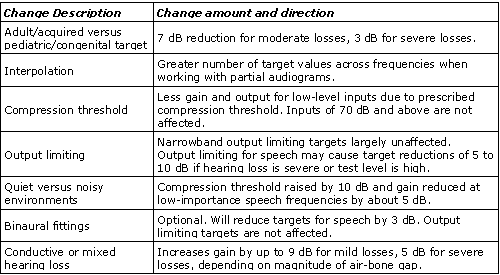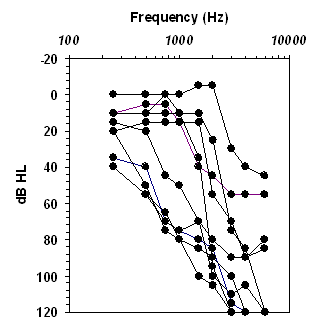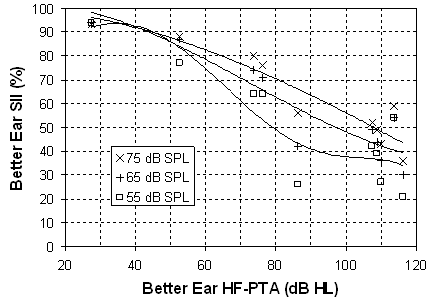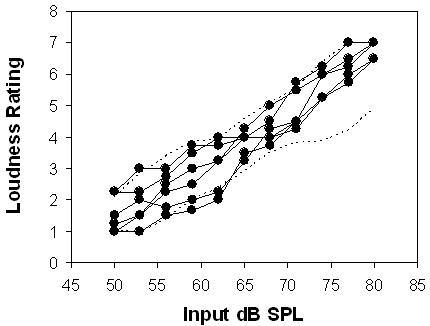In 2005, a new version of the Desired Sensation Level (DSL) prescriptive formula was released. Version 5.0 of DSL® updates both the protocols and targets from DSL v4.1. In this article, I will review some of these changes and present some early outcomes from children who have received DSL v5.0 fittings in our laboratory.
How have the protocols changed in DSL v5.0?
Prior to v5.0, DSL was designed for children and adults. We now use different protocols for each of three populations: infants, children, and adults (Bagatto et al., 2005). The main addition here is the infant-specific protocol, which we've designed so that use of DSL in early intervention programs is clear. For infants, the protocols include using estimated thresholds, likely from frequency-specific auditory brainstem response (ABR), as the basis for hearing aid fitting (Bagatto et al., 2005; Scollie, 2006). Also, we now have updated normative data for the Real Ear to Coupler Difference (RECD) that are better suited to hearing aid fitting in infancy. These new norms are good, but the preferred protocol is the use of a new procedure for infant-friendly RECD measurement to further individualize the fitting (Bagatto et al., 2006). Protocols for infants and children maintain the coupler-based verification protocol from previous versions of DSL. This approach minimizes the amount of cooperation needed from the child while maximizing the utility of probe-microphone measurements. For all ages, our protocols use the Real Ear Aided Response (REAR), either predicted or directly measured, on an SPLogram display to facilitate comparisons among hearing aid responses, detection thresholds, and Upper Limits of Comfort (ULC; Seewald et al., 2005).
How have the targets changed in DSL v5.0?
The rationale and changes in DSL v5.0 are described in a recent publication (Scollie et al., 2005). In general, the targets are now more flexible than they have been in past versions. There is no longer a single DSL "target" but rather a family of targets that vary based on the type of fitting. The following section will summarize the factors that have been implemented to adjust the targets, and give a sense of the type of changes that result. The changes discussed here are also summarized in Table 1.
Age and etiology: One of the largest changes, both conceptually and in order of magnitude, is the change in targets based on the listener's age and etiology. DSL v5.0 is adjusted to recommend a higher listening level for pediatric patients (presumably with congenital hearing losses) than for adult patients (presumably with acquired hearing losses). Clinically, this is selected by the clinician rather than automatically based on birthdate, so that either target type can be chosen - for example, for adults who have congenital hearing losses or who prefer a setting that provides maximal audibility of speech.
The rationale for having a target that varies by age/etiology is evidence based. Numerous studies have demonstrated adult-child differences in performance ceilings, loudness ratings, and preferences by listening level (see the review in Scollie et al., 2005). Across studies, the size of this difference appears to be greater than 5 dB and likely less than 10 dB, where children both require and prefer greater gain than do adults. DSL v5.0 accommodates this difference by reducing the gain recommended for adults by 7 dB for a 50 dB HL audiogram and a 60 dB SPL speech input (Scollie et al., 2005). As hearing levels increase, we use a gradually decreasing adult-child difference in order to maintain audibility of the speech signal for both populations. Therefore, for hearing losses greater than about 80 dB HL, the age-related difference in target is very small.
Treatment of missing data: In pediatric audiology, it is very common to fit hearing aids based on threshold data at only two, three, or four frequencies per ear. In previous versions of DSL, targets were computed only at frequencies with measured thresholds. This meant that thresholds were interpolated and/or extrapolated by the manufacturer within hearing aid fitting software. It is likely that this was not done the same way in all cases. DSL v5.0 now includes an interpolation routine to derive a full spectrum of targets for any audiogram for two or more thresholds. This interpolation may not be shown in the fitting screens of all systems, but will be implemented whenever a manufacturer chooses to provide interpolation.
Compression characteristics: Version 5.0 of DSL uses a new input/output algorithm that is based on DSL[i/o]. It has been modified to include channel architecture: the target input/output functions can be clustered according to the channels of the hearing aid, so that compression targets per channel are computed. It also can include an optional expansion stage so that low-level targets are appropriately calculated for hearing aids with expansion. The matching of channel structures between the prescription and the hearing aid will most often be done within hearing aid fitting software, and likely will be "behind the scenes", since the clinician rarely to never changes the number of channels in the hearing aid. Real-ear systems using speech as a test signal can derive DSL v5.0 targets without adjustments for channel structure, since the effects of channel structure are minimized by testing with speech.
Compression thresholds (CTs), or kneepoints, are also revised in DSL v5.0. In DSL v4.1, the CT was assumed to be very low, but could be overridden by the clinician. However, no specific target was provided for raising the CT to an achievable level. Also, the DSL v4.1 CT was computed per audiometric frequency, without modification for the channel structure of the hearing aid. In practice, a low compression threshold can be difficult to achieve, particularly for greater hearing losses, and CT settings often vary by channel. In DSL v5.0, a channel-specific CT prescription recommends a low compression threshold for milder hearing losses. The prescribed CT is about 50 dB SPL for moderate hearing losses, and is gradually raised as hearing loss increases, to about 70 dB SPL for severe to profound losses. The prescribed CT may be overridden by the clinician or by fitting software. Lower-than-prescribed CTs can be selected at the time of fitting, and may be more feasible and beneficial when used with effective feedback controls. Clinicians are also advised that lower CTs may also increase audibility of background noise, thus, such adjustments should be made carefully.
Limits to high-level speech: Speech energy fluctuates over time. Therefore, the average level of aided speech (as described by the long term average speech spectrum, or LTASS) is only one way to describe speech energy. One useful addition to an LTASS measurement is an estimate of the peaks of speech, which are typically about 10 or 12 dB above the LTASS level at each frequency (Cox, Mateisch, & Moore, 1988). The difference between the LTASS and the speech peaks is the crest factor of speech. Experimental evidence shows us that modern hearing aids, even those with multichannel processing, exhibit at least 9 dB of crest factor (Scollie et al., 2005).
In DSL v5.0, the targets for aided speech are limited so that speech peaks do not exceed the listener's ULC. Because the speech peaks and the LTASS are electroacoustically tied to one another, this can have the effect of limiting the LTASS target values through a target variable called the Broadband Output Limiting Thresholds, or BOLT. This makes targets appear somewhat lower than they were in DSL v4.1 for the same audiogram. This does not reflect a change in target goals, but rather is a reflection of real limits imposed by most output limiting systems. BOLT-limited targets are most likely to occur for higher input levels and/or severe hearing losses, and can be identified by a target LTASS that parallels the ULC contour, and is exactly 13 dB below the ULC.
Listening Environments: DSL targets for speech are computed assuming that spoken communication is taking place in a quiet environment, and therefore aims to provide full, or nearly full, audibility of speech. In noisy environments, this degree of audibility may decrease comfort without improving intelligibility. Frequency-modulated (FM) systems and directional microphones are known to increase the speech-to-noise ratio (SNR), thereby enhancing intelligibility. However, some hearing aid fittings also provide a reduced-gain program for use in noise. Gain reduction in noise is not likely to improve intelligibility but may increase listening comfort without reducing intelligibility. DSL v5.0 provides targets for a noise program that combines less gain at speech frequencies of lower importance with a raised CT.
Other changes: DSL v5.0 includes an optional binaural correction that reduces speech targets by 3 dB. Sloping losses receive a small adjustment that provides more mid-frequency and less high-frequency gain. Targets for conductive and mixed hearing loss are slightly higher than for sensorineural hearing losses, for both speech-level and maximum output targets. This is done by raising the predicted ULC by 25% of the average air-bone gap. This raises the upper limit of the target input/output curve slightly, resulting in small corrections for most audiograms. For a maximal air-bone gap, the correction adds 5 to 9 dB of gain and output to the aided speech targets, depending upon the hearing level.
Table 1. Summary of target changes in DSL v5.0.

Clinical use of DSL v5.0
DSL v5.0 is now available for implementation in manufacturers' test systems and hearing aid fitting software. The first of these implementations has recently been released for clinical use. One such example is the use of DSL v5.0 in the Audioscan Verifit® hearing aid analyzer and probe microphone system. The next sections will discuss the use of DSL v5.0 as implemented in this system, and provide some early results from pediatric hearing aid fittings in our laboratory.
Verification of Maximum Output
One of the changes in the Verifit implementation of DSL v5.0 is a more detailed display of maximum output targets. In the DSL 4.1/Verifit software, the ULCs were displayed and used as a target for the "MPO" test signal, which uses a narrowband stimulus presented at 85 or 90 dB SPL. It was fairly typical for measured MPO responses to be well below the ULC, especially for hearing aids with wide dynamic range compression (WDRC). The compression of the hearing aid reduced the level of the MPO test signal, preventing it from reaching full saturation. Because the ULC target is really intended to be matched by fully saturated hearing aid responses, a slightly lower target may be more appropriate for use with the MPO test signal. For this reason, the target input/output function within DSL v5.0 can be used to compute a level-dependent target for either 85 dB SPL (in the real ear) or 90 dB SPL (in the coupler, using simulated real ear measurement). This new target will be somewhat lower than ULC for most hearing losses.
An example of this target difference is shown in Figure 1. The ULC targets are shown as black asterisks - these targets are equivalent to the previous ULC targets from DSL v4.1. The new, level-dependent MPO targets are shown as green crosses - they are somewhat lower than ULC because the target input/output function is not fully saturated at a 90 dB SPL input for this hearing loss. The hearing aid's measured response (shown by the green line) provides a good match to the 90 dB targets, even though it would have appeared "under target" if it had only been compared to ULC. This displayed MPO response would be judged as an appropriate setting for this prescription.

Figure 1. Sample verification data for a hearing aid fitting to DSL v5.0 targets, using a narrowband evaluation of maximum output and three levels of speech.
Verification of Output for Speech
DSL v5.0 targets are calculated assuming a speech input; therefore, verification of fit to specified targets using a speech stimulus provides a good electroacoustic evaluation of hearing aid function. For best accuracy, the test signals and speech are both defined as long-term levels in one-third octave bands. An example of this is also shown in Figure 1. The DSL v5.0 targets for 65 dB SPL speech are at the center of each blue cross. The vertical bars on each cross visually indicate a +/- 3 dB fitting tolerance, to reflect the notion that fit to targets is rarely perfect across frequencies. The real ear aided response (REAR) for 65 dB speech is shown by the heavy blue line. This measurement is supplemented by measures of aided speech peaks and valleys, which limit the blue hatched region. Overall, the measurement indicates that the fitting is at, or slightly below targets up to almost 4000 Hz. Even where the fitting falls slightly below targets, it still provides full audibility of speech (i.e., the valleys of speech are at or above threshold).
In this fitting, the binaural correction within DSL v5.0 is disabled (see the menu item on the right of Figure 1). This correction subtracts 3 dB from all speech targets at all frequencies. Essentially, this fitting would be considered on target with the binaural correction activated. The literature is not conclusive on whether a gain reduction is needed for binaural fittings in children. This element of DSL v5.0 requires further investigation. Until conclusive results are available, the use of the binaural correction is an option that clinicians can choose to use or disable at their discretion. For this reason, the fitting shown in Figure 1 could either be left as shown, or adjusted to have slightly more gain. Such adjustments should be evaluated to ensure that the child is receiving the best possible performance from the hearing aid. We used a computer-controlled test specially developed in our lab to evaluate speech recognition. The test is closed-set and the stimuli consists of 10 vowels and 10 consonants with high-frequency emphasis spoken by a female talker. The results indicated that 100% of vowel sounds and 72% of high-frequency consonants were correctly understood at a test level of 50 dB SPL. Aided loudness ratings indicated that loudness perception was within the normal range; this child rated real-world listening performance at 7.5 out of 8 on the Children's Home Inventory for Listening Difficulties (CHILD) questionnaire (Anderson & Smaldino, 2001). Based on these findings, this hearing aid was left at the settings shown in Figure 1.
Older children may indicate preference for fine tuning around a set of prescriptive targets, much as adults do. In some cases, the targets in DSL v5.0 may be slightly lower than targets in DSL v4.1 for reasons shown in Table 1. Children who are accustomed to a given level of output may prefer to have their hearing aids remain at such a setting*. In our preliminary sample of children, 3 have preferred responses slightly over target in the low to mid frequencies, 2 have preferred responses slightly under target in the low frequencies, and 5 have been satisfied with responses at target. In no case was the maximum output response adjusted to exceed target values.
Supplementing Fitting Analysis with the Speech Intelligibility Index (SII)
The Audioscan Verifit provides SII values as a supplementary analysis when the SpeechMap® software is used. The SII is not a part of DSL v5.0, but the two can be used together when verifying hearing aid fittings. This section will provide a brief overview of the SII, and show some examples of clinical results.
The former Articulation Index was revised in 1997 and renamed the Speech Intelligibility Index (ANSI, 1997). This index summarizes the proportion of speech that is audible and undistorted in a speech signal, and can be expressed as a proportion (out of zero) or as a percentage (out of 100). Although not originally developed for hearing aids, it is often modified for use with hearing losses and/or hearing aid-processed speech. One such modification is the SII computation available in the Audioscan Verifit. This version of the SII is based on the real ear SPL thresholds and measured Real Ear Aided Responses from the hearing aid. As such, it describes the overall audibility present in the hearing aid fitting as a percentage value. For example, the fitting shown in Figure 1 provides 64% speech audibility for soft speech, 74% for average speech, and 80% for loud speech. These values are often easy for parents or teachers to understand and provide a good summary of the audibility provided by the hearing aid. It is important to remember though that SII values do not indicate the proportion of speech that will be understood by the hearing aid user. Speech understanding depends on development, the type of speech material, the listening environment, and a host of other factors in addition to audibility.
Clinicians who are not accustomed to using the SII often inquire about the percentage or level of SII that should be attained for a typical hearing aid fitting. This is most common when fitting to severe or profound hearing losses, where observed SII values are often low, due to limitations of fit to targets and limitations imposed by the SII standard itself. Specifically, the SII standard includes a level distortion factor that reduces the estimated SII for any speech spectrum that is higher than 62.4 dB SPL. The reduction is slight for conversational speech or even for raised voice speech. However, for high levels produced by aided speech intended for a severe or profound hearing loss, the level distortion factor can reduce the SII in a noticeable way. Clinically, this can make the SII value appear lower than one would expect, based only on the apparent audibility of the aided speech spectrum on the SPLogram/Speechmap display. The question is, how much lower?
We can get a sense of "typical" SII values for DSL v5.0 fittings by looking at values from our laboratory. We are currently evaluating DSL v5.0 in children. To date, 10 children (average age=11 years, range= 7 to 17 years) have been fitted with hearing aids using speech-based real ear verification. Better ear thresholds ranged in pure-tone average from mild to severe levels (Figure 2). Hearing aids were fitted binaurally and verified using running speech at input levels of 55, 65, and 75 dB SPL, using simulated real ear measurement with individually measured RECDs.

Figure 2. Better ear air conduction thresholds for a sample of 10 children with hearing impairment.
To summarize the SII scores, unaided hearing levels were compared to aided SII values as follows. The children's better-ear high frequency pure tone average (HF-PTA) thresholds were calculated as the average from 2000 through 6000 Hz. The observed SII values from hearing aid verifications were taken from the Audioscan Verifit screen, and the better-ear SII was selected. These better-ear SII scores are plotted against the better-ear HF-PTA thresholds in Figure 3. Two trends are clear in these data. First, as unaided hearing levels increase, the SII values are lower. This is due in part to a poorer fit to targets as hearing levels increase, and in part to the SII level distortion factor. Second, as the unaided level of speech decreases, the SII also decreases; this occurs mostly for hearing levels above 80 dB HL. This reflects the fact that higher input levels of speech tend to have more audibility than lower levels of speech, particularly for more severe losses. It also reflects the hearing-level-dependent compression threshold in DSL v5.0. That is, DSL v5.0 recommends a higher compression threshold as hearing loss increases (to accommodate limitations from gain limits and feedback). For this reason, it is not unexpected that DSL v5.0 fittings would have lower SII values for soft (i.e., 55 dB SPL) speech versus conversational (i.e., 65 dB SPL) speech. In general, the aided SII was better than 60% for losses of 75 dB HL and better. For losses of 80 dB HL and poorer, the SII value varied between 20% and 60%, depending upon the hearing level, test level, audiometric configuration, and fit to targets. Even above 80 dB HL, SII values were at 35% or better for conversational speech inputs of 65 dB SPL. This is a small data set, but it does provide initial examples of attainable SII values when using DSL v5.0 targets as a starting point.

Figure 3. Better-ear high frequency pure tone average (HF-PTA) thresholds versus better-ear aided Speech Intelligibility Index (SII) scores for 10 children fitted with hearing aids using DSL v5.0. SII values were measured at three input levels. Lines indicate polynomial fits to the hearing loss versus SII data per input level.
Preliminary Loudness Outcomes
The aided loudness ratings for the sample of 10 children described above were measured using the Contour test (Cox, Alexander, Taylor, & Gray, 1997), with the Rainbow passage as the stimulus. To date, six of the ten children have completed this task, with the remainder either yet to return to the lab for this testing, or too young to reliably complete the task. The six children heard one sentence of the Rainbow passage, made a loudness rating within computer software, and then heard and rated the next sentence of the passage, and so on. Ratings were elicited for input levels from 50 through 80 dB SPL, in 3 dB steps using an ascending/descending presentation order. Ratings for two ascending/descending runs were averaged together to generate final scores. Results are shown against the 95% confidence interval for ten young adults with normal hearing on the same task (Figure 4). These data indicate that the loudness associated with these DSL v5.0 fittings is generally normalized. This is not surprising given that DSL v4.0 targets were also shown to provide loudness normalization for aided speech (Jenstad, Pumford, Seewald, & Cornelisse, 2000). Recall, however, that some fine tuning to preference was made for some of these children, with changes both over and under target. Further evaluation is needed, but these early results are encouraging.

Figure4. Aided binaural loudness ratings for six children fitted with DSL v5.0.
Final thoughts
Current recommendations for clinical practice in pediatric amplification suggest that prescriptive algorithms may be a good starting point for children's hearing aid fittings (AAA, 2004). A thorough verification protocol accounts for the child's occluded ear canal acoustics and earmold effects, as well as the hearing aid's response for speech. The cases presented in this article combine these two elements using a new prescription that can be appropriately paired with modern hearing aid technology. This new prescription, DSL v5.0, is intended for use with multichannel compression hearing aids, and aims to provide appropriate audibility of a wide range of speech levels for infants and children who use hearing aids. As with any clinical tool, comprehensive evaluation of DSL v5.0 is necessary, and the cases presented here are an early part of this evaluation.
Footnote
* A general guideline is that the DSL v5.0 targets are most similar to DSL v4.1 targets with the age variable set to "child" and with the binaural correction disabled.
References
American Academy of Audiology. (2004). Pediatric Amplification Protocol. Audiology Today, 16(2), 46-53.
American National Standards Institute (1997). Methods for calculation of the Speech Intelligibility Index, ANSI S3.5-1997. New York: Acoustical Society of America.
Anderson, K. & Smaldino, J. (2001). Children's Home Inventory of Listening Difficulty. Retrieved December 14, 2006, from www.phonak.com/professional/pediatrics/diagnostic.htm
Bagatto, M.P., Moodie, S., Scollie, S.D., Seewald, R.C., Moodie, K., Pumford, J., & Liu, K.P.R. (2005). Clinical protocols for hearing instrument fitting in the Desired Sensation Level method. Trends in Amplification, 9(4), 199-226.
Bagatto, M.P., Seewald, R.C., Scollie, S.D., & Tharpe, A.M. (2006). Evaluation of a technique for measuring the real-ear-to-coupler difference (RECD) in young infants. Journal of the American Academy of Audiology, 17(8), 573-581.
Cox, R.M., Mateisch, J.S., & Moore, J.N. (1988). Distribution of short-term RMS levels in conversational speech. Journal of the Acoustical Society of America, 84, 1100-1104.
Cox, R.M., Alexander, G.C., Taylor, I.M., & Gray, G.A. (1997). The contour test of loudness perception. Ear and Hearing, 18, 388-400.
Jenstad, L.M., Pumford, J., Seewald, R.C., & Cornelisse, L.E. (2000). Comparison of linear gain and wide dynamic range compression hearing aid circuits: Aided loudness measures. Ear and Hearing, 21, 32-44.
Scollie, S.D. (2006, March 13). Fitting hearing aids to babies: Three things you should know. Audiology Online, Article 1545. Retrieved December 14, 2006 from the Articles Archive on www.audiologyonline.com. Direct access URL located at: audiologyonline.com/articles/article_detail.asp?article_id=1545
Scollie, S., Seewald, R., Cornelisse, L., Moodie S., Bagatto, M., Laurnagaray, D., Beaulac, S., & Pumford, J. (2005). The Desired Sensation Level Multistage Input/Output Algorithm. Trends in Amplification, 9(4), 159-197.


